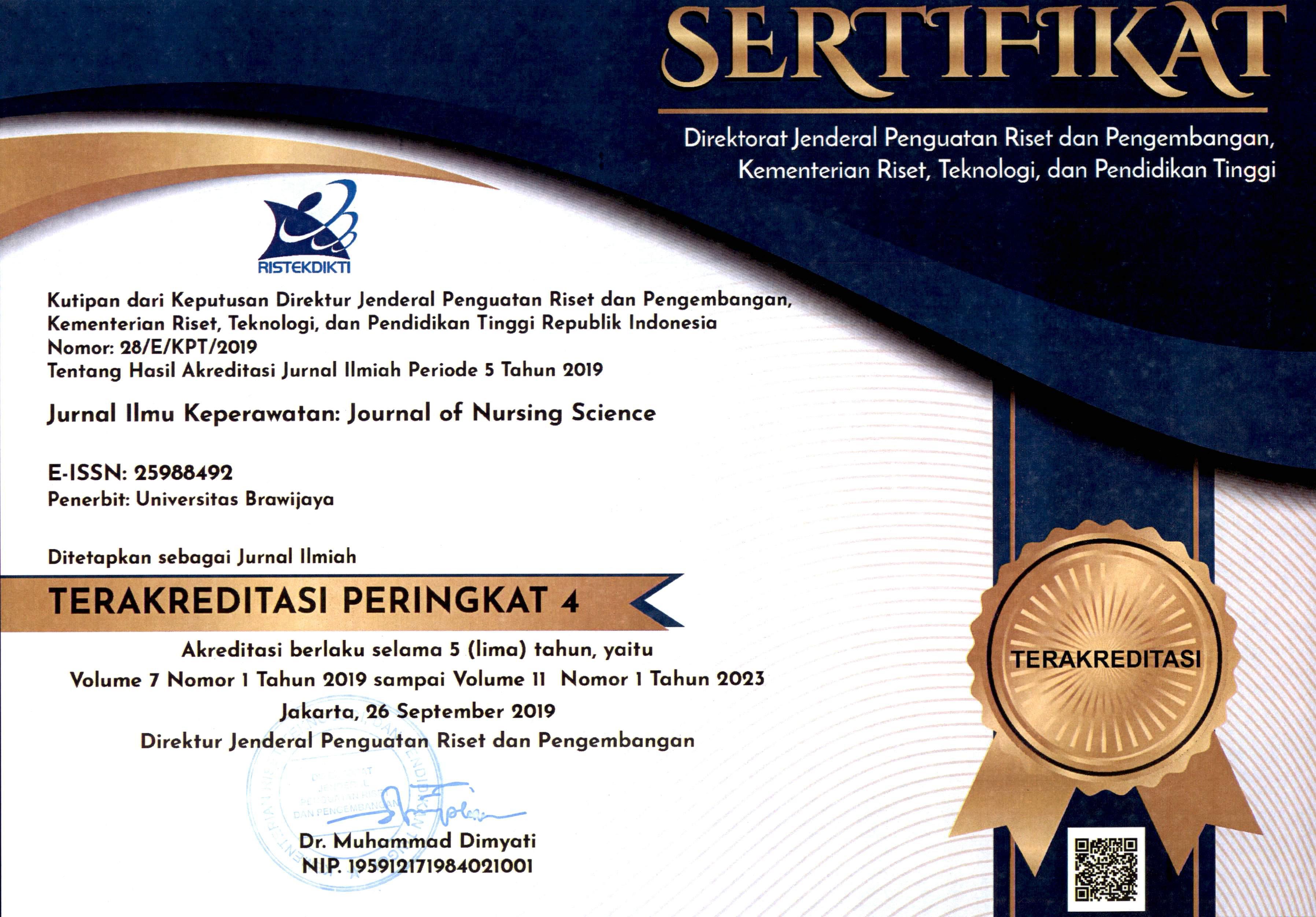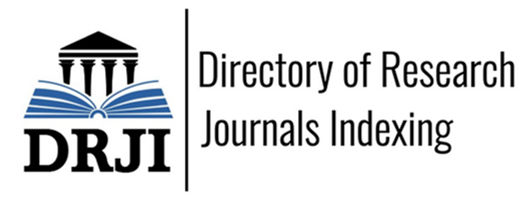REDUCING FATIGUE SCORE WITH PHYSICAL EXERCISE IN CHILDREN WITH CANCER
DOI:
https://doi.org/10.21776/ub.jik.2017.005.02.4Keywords:
cancer, cancer medication, fatigue, physical activityAbstract
Physical problems that often arise in children with cancer include fatigue. Fatigue or tiredness is a condition that leads to stress and a deep problem for patients suffering from cancer. Nursing interventions on cancer-related fatigue which quite effective is regular physical exercise. The purpose of this study was to identify the relationship of physical exercise with a score of fatigue in children with cancer. The method used is descriptive analytic with cross sectional study. The study was conducted in Child Care ward of DR. M.Djamil Hospital In May and October 2015. The sample in this study were 30 children with cancer who undergoing chemoteraphy that taken with accidental sampling technique. Data collection was a questionnaire about fatigue scores in children and child physical exercise performed before undergoing chemotherapy. Data were analyzed by independent t test. The mean score of fatigue in children who do physical exercise was 39.86 with a standard deviation of 6.98. In children who do not do physical exercise, the average fatigue score was 46.62 with a standard deviation of 7.60. it can be concluded that there was a significant differences in fatigue scoring between children who did physical exercise and didnt do that ( p value 0.017).
In conclusion physical education programs in patients with cancer are hopefully controlled, coordinated and sustainable, and became one of the nursing intervention in patients with cancer who experience fatigue.
References
- American Cancer Society. (2008). Cancer statistics presentation 2008. Diakses dari http://www. cancer. org/docroot/ LPRO/ pada tanggal 13 Januari 2011.
- American Cancer Sosiety. 2015. Cancer in children. Atlanta, Ga: American Cancer Sosiety.
- Ball, J. W., & Bindler, R. C. (2003). Pediatric of nursing: Caring for children. New Jersey: Pearson Education, Inc.
- Barsevick, A., Frost, M., Zwinderman, A., Hall, P., & Halyard, M. (2010). ‘I am so tiredâ€: biological and genetic mechanism cancer related fatigue. Qual life res, 19, 1419-1427.
- Barsevick, A.M., Irwin, M.R., Hinds, P., et al. (2013). Recommendation for high priority research on cancer related to fatigue in children and adults. JNCI, 105; 19.
- Belmore, J., & Tomlinson, D. (2010). Fatigue dalam Tomlinson, D., & Kline, N.K, Nursing advanced clinical handbook, 2ndd (hlm. 454). Heidelberg: Springer.
- Cameron, P., & Allen, P.J. (2009). Cisplatin ototoxicity in children: Implications for primary care providers. Pediatric Nursing, 35 (2), 121-127
- Campbell, A et al. (2011). The important physical activity for people living and beyond cancer. Diakses dari www.macmila.org.uk pada tanggal 18 Juni 2015, pukul 07.13.
- Cancer Research UK. 2015. Childhood cancer. Diakses dari www.cruk.org.cancerstats pada tanggal 15 November 2015, pukul 07.32.
- Chiang, Y.C., Yeh, C.H., Wang, K.W.K., & Yang, C.P. (2009). The experience of cancer related fatigue in Taiwanese children. European Journal of Cancer Care, 18, 43-49.
- de Nijs, E.J.M., Ros, W., & Grijpdonck, M.H. (2008). Nursing intervention for fatigue during the treatment for cancer. Cancer NursingTM ,31,3, 191-205.
- Enskar, K., & von Essen, L. (2008). Physical problems and psychosocial function in children with cancer. Pediatric Nursing, 23 (3), 37-41
- Hanna, L.R., Avila, P.F., Metter, J.D., Nicholas, D.R., & Kaminsky, L.A. (2008). The effect of a comprehensive exercise program on physical function, fatigue and mood in patients with vaious types of cancer. Oncology Nursing Forum, 35 (3), 461-469.
- Hinds, P.S., Hockenberry, M.J., Gattruco, J.S., Srivistava, D.K., Tong, X., et al. (2007). Dexamethasone alters sleep and fatigue in pediatric patients with acute lymphoblastic leukemia. Cancer, 110(10), 2321-2330.
- Hockenberry, M.J et al. (2003). Three instrument to asses fatigue in children with cancer: the child parent and staff perspectives. Journal of Pain and Symptom Management, 25 (4), 319-327.
- Hockenberry, M.J & Wilson, D. (2009). Wong’s essentials of pediatric nursing (hlm. 51-64). St Louis: Mosby Inc.
- Hockenberry, M.J., Hooke, M.C., Gregurich, M., McCarthy, K., Sambuco, G., & Krull, K. (2010). Symptom cluster in children and adolencents receiving cisplatin, doxorubicin, or ifosfamide. Oncology Nursing Forum, 37 (1), E16-E27.
- Johnson, J. Y., & Keoght, (2010). Pediatric nursing demystified, (hlm 147-171). New York: Mc Graw Hill.
- Muscari, M. E. (2005). Panduan belajar: Keperawatan pediatric. Jakarta: EGC.
- Mustian,K.M., Sprod, L.K., Janelsins, M.J., Peppone, L.J., & Mohile. S. 2013. Exercise recommendations for cancer-related fatigue, cognitive impairment, sleep problems, depression, pain, anxiety, and physical dysfunction: a review. Oncol Hematol Rev, 8 (2): 81-88.
- National Cancer Institute. ( 2007). Cancer incidence and survival among children and adolescence United States SEER program 1975 to 1995. Diakses pada tangal 13 Januari 2011, dari http://seer.cancer. gov/ publications/ childhood.
- NCCN. (2011). NCCN clinical practice guidelines in oncology (NCCN guidelines): Cancer related fatigue, version I.2011. National Comprehensive Cancer Network, diakses dari www.NCCN.org pada tanggal 04 Maret 2012, pukul 10.00.
- Perdikaris, P., Merkouris, A., Patiraki, E., Papadatou, D., Kosmidis, V., & Matziou, V. (2008). Change in children’s fatigue during the course of treatment fo pediatric cancer. International Nursing review, 55, 412-419.
- Potter, P.A., & Perry, A.G. (2010). Buku ajar fundamental keperawatan : Konsep, proses, dan praktik/ Patricia. A. P., Anne Griffin Perry, alih bahasa Yasmin Asih et al. Editor edisi bahasa Indonesia, Devi Yuliant, Monica Ester. Jakarta : EGC.
- Scholes, S., & Mindell, J. 2012. Physical activity in children. HSE, Vol 1; The Health and Social Care Information Center.
- Tomlinson, D., Zupanec, S., Jones, H., et al. (2016). The lived experience of fatigue in children and adolescents with cancer: a systematic review. Support Care Cancer, 24: 3623, doi: 10.1007/s00520-016-3253-8
- Van Waart, H., Stuiner, M.N., van Haarten, W.H., Sonke, G.s>, & Aoronson, N.K. Chemotherapy effectiveness study (PACES): A randomized controlled trial to evaluated effectiveness and cost effentiveness of physical exercise improving physical fitness and reducing fatigue. BMC Cancer, 10: 673 diakses dari www.biomedcentral.com pada tanggal 18 Juni 2015, pukul 07.45.
- Wang, X.S. (2008). Pathophysiology of cancer-related fatigue. Clinical Journal of Oncology Nursing, 12 (5), 11-22.
- Yeh, C.H et al. (2008). Clinical factor associated with fatigue over time in pediatric oncology patients receiving chemotherapy. British Journal of Cancer, 99, 23-29.
- Yeh, C.H et al. (2011). A pilot study to examine feasibility and effects of ahome base aerobic program in reducing fatigue in children with acute lymphoblastic leukemia. Cancer Nursing, 34, 3-12.
- Yeh, CH., Chinga, Y.C., Yang, C.P., Chie, L.C., Weaver, M.A., & Chuang, H.L. (2008). Clinical factors associated with fatigue over time in pediatric oncology patient receiving chemotherapy. British Journal of Cancer, 99: 23-29.
- Yilmas, H.B. (2012). Fatigue in Pediatric Oncology Patients, Contemporary Pediatrics, Dr. Öner Özdemir(Ed.), ISBN: 978-953-51-0154-3, InTech, Available from: http://www.intechopen.com/books/contemporarypediatrics/fatigue-in-pediatric-oncology-patients .
Downloads
Published
How to Cite
License
Authors published in this journal agree to the following terms:
1. The copyright of the received article shall be assigned to the journal as the publisher of the journal. The intended copyright includes the right to publish the article in various forms (including reprints). The journal maintains the publishing rights to the published articles.
2. Authors may enter into separate additional contractual agreements for the non-exclusive distribution of the published journal version of the work (for example, posting it to an institutional repository or publishing it in a book), with acknowledgment of their initial publication in this journal.
3. Authors are permitted and encouraged to post their work online (e.g. in an Institutional Repository or on their website) before and during the submission process, as this can result in a productive exchange, as well as earlier and larger citations of the published work.
4. Articles and all related material published are distributed under Creative Commons Attribution-NonCommercial 4.0 International License or CC BY-NC 4.0 license.
JNSU is licensed under a Creative Commons Attribution-NonCommercial 4.0 International License or CC BY-NC 4.0 license.





























